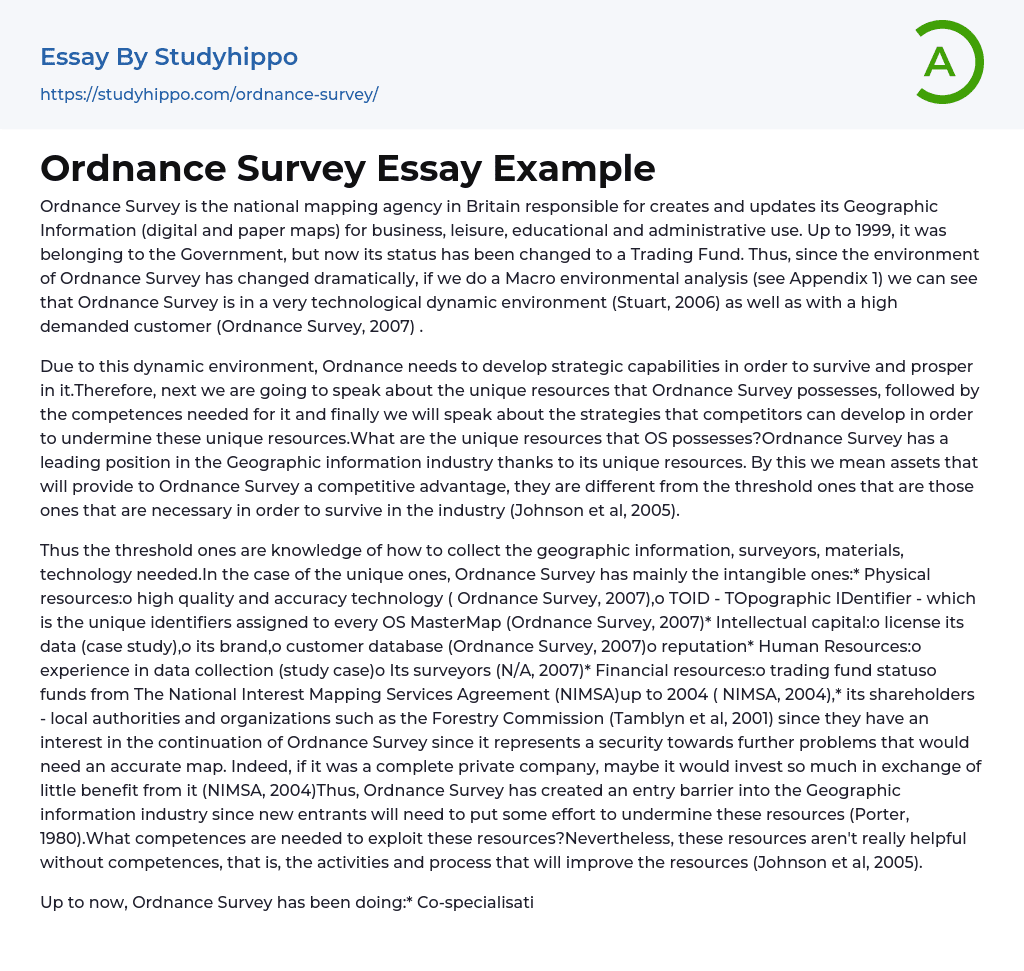Ordnance Survey, the national mapping agency in Britain, is responsible for creating and updating Geographic Information in the form of digital and paper maps for various purposes such as business, leisure, education, and administration. Previously a government-owned entity, it is now a Trading Fund since 1999. This change has brought about a significant shift in Ordnance Survey's environment, making it susceptible to a highly dynamic technological landscape (Stuart, 2006) while also catering to demanding customers (Ordnance Survey, 2007). A macro environmental analysis (refer to Appendix 1) would reveal the challenges faced by Ordnance Survey in this context.
Ordnance Survey must develop strategic capabilities to survive and thrive in a dynamic environment. The company's unique resources give it a leading position in the Geographic information industry, providing a competitive advantage over threshold resources necessary for survival. In this article, we will discuss Ordnance Surve
...y's unique resources, necessary competences, and strategies competitors can use to undermine these resources.
The threshold requirements for collecting geographic information include knowledge, surveyors, materials, and technology. Ordnance Survey possesses unique resources including high-quality and accurate technology, the TOID system for identifying every OS MasterMap, intellectual capital including data licensing, its brand, customer database, reputation, surveyor experience, financial resources such as trading fund status and funds from NIMSA up to 2004, and shareholder support from local authorities and organizations like the Forestry Commission who value accurate mapping for security purposes.The investment in exchange for little benefit from a complete private company may not be worth it (NIMSA, 2004). Consequently, Ordnance Survey's resources have created a barrier to entry in the Geographic information industry, requiring new entrants to put in effort to undermine them (Porter
1980). However, competences are necessary to effectively exploit these resources. This involves engaging in activities and processes that enhance the resources (Johnson et al, 2005).
Ordnance Survey has implemented several strategies to remain competitive in the Geographic Information industry. One approach is co-specialisation and partnership, which creates dependence from customers while also allowing for the generation of innovative ideas from other fields. Additionally, the company invests in new technologies such as their Master Map Integrated Transport Network that provides unparalleled accuracy in the British market. Ordnance Survey is also dedicated to innovation to adapt to market changes, including rapid improvements in data collection and meeting customer needs. This has led to the incorporation of 3D mapping technology like IR and LIDAR. The company prioritizes better supply management and is highly protective of their copyright. (Smith, 2007; Stuart, 2006; Ordnance Survey, 2007; N/A, 2007).
Ordnance Survey, in 2007, had data available for purchase that was categorized into two customer segments: graphic-based and digital-based products. The segmentation aided in effectively targeting customers and was a result of the competencies developed by the company. These competencies were customer-oriented and dynamic, which gave Ordnance Survey a competitive advantage (Tamblyn et al, 2001; Ordnance Survey, 2007; Stuart, 2006). Competitors could undermine these resources through substitution by offering alternative options at a better price or even for free, such as satellite or aerial data. According to Porter (1980), these alternatives perform the same function as Ordnance Survey data and are thus substitutes. The Product Life Cycle framework (Day, 1981) suggests that products function in a standard way in the market, going from growth to decline with phases of maturity and saturation in between.
Ordnance
Survey's data has reached its saturation point, largely due to advances in technology and increased customer demand. As a result, it is easier for better products to challenge the capabilities of the saturated product. The company has historically been known for its paper maps, but with the evolution of technology, they've been replaced by electronic versions for mobile devices (Stuart, 2006). In the past, Ordnance Survey's competitors have been able to supplant their resources by being more innovative. However, today competitors could undermine Ordnance Survey's uniqueness by providing free geographic information without copyright, giving anyone the opportunity to take advantage of this type of information. Another way competitors could undermine Ordnance Survey is by offering better services since it's difficult to compete with a different geographic information database (Oxera, 1999).
Both Bentley (www.bently.com) and Intergraph (www.intergraph) are offering unique solutions in the Geographic industry. Bentley is taking a two-tier approach and also providing a full enterprise solution. Intergraph is integrating special information and security services into their offering.
According to Johnson et al (2005), sustainable competitive advantage can be achieved through complex linkages of competences. This is demonstrated by the examples of Ordnance Survey's competitors. Furthermore, suppliers pose another threat to Ordnance Survey's resources as they can not only stop supplying but also create their own data or provide competing services, as described by Porter (1980).
- Auction essays
- Balanced Scorecard essays
- Business Plans essays
- Expense essays
- Income essays
- Net Income essays
- Security Guard essays
- Singapore Airlines essays
- Battle essays
- Intranet essays
- Maintenance essays
- Simulation essays
- Inn essays
- Chief Executive Officer essays
- Convenience Store essays
- Firm essays
- Training And Development essays
- Unilever essays
- Variable Cost essays
- Virgin Group essays
- Bargaining essays
- Entity essays
- Pest analysis essays
- Leadership and Management essays
- Change Management essays
- Project Management essays
- Knowledge Management essays
- Operations Management essays
- Quality Management essays
- Risk Management essays
- Scientific Management essays
- supply chain management essays
- Performance Management essays
- Time Management essays
- Brand Management essays
- Total Quality Management essays
- Risk essays
- Manager essays
- Leadership essays
- Business Ethics essays
- Board Of Directors essays
- Product Management essays
- Comparative Analysis essays
- Decision Making essays
- Dispute Resolution essays
- Stress Management essays
- Business Management essays
- Brand Equity essays
- Branding essays
- Nike, Inc. essays




